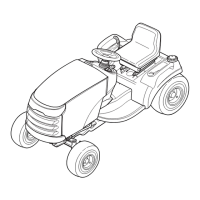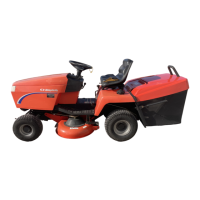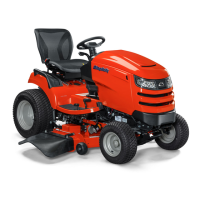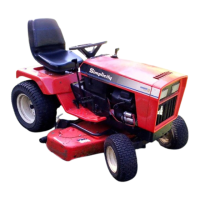FEATURES AND CONTROLS
14
Parking Brake Function
Applying the Parking Brake - See Figure 2. To lock the
parking brake, release the ground speed pedals (A), fully
depress the brake pedal (B), pull UP on the parking brake
knob (C), and then release brake pedal.
Releasing the Parking Brake - See Figure 2. To release
the parking brake, fully depress the brake pedal (B) and
push the parking brake knob (C) DOWN.
IMPORTANT NOTE: The tractor’s hydraulic attachment lift
will not work when the parking brake is engaged.
12-Volt Power Outlet
The 12-volt accessory plug is located in the left side pod. It
can be used to power small electronic devices. The acces-
sory must be rated at 14 amps or less.
NOTE: Operating a 12-volt accessory, especially with the
engine at idle, may cause battery discharge. When not using
the accessory plug it must be covered with the rubber plug
to prevent moisture from causing a short circuit. Entrance of
water into plug can cause a short circuit.
Attachment Lift Control Lever
When using the mower deck, lift the deck off the ground
while transporting to and from the job site. DO NOT cut
with the mower in the raised, transport position. The at-
tachment lift control lever raises and lowers attachments
that utilize the tractor’s hydraulic lift cylinder. Pushing the
lever forward lowers the attachment while pulling the lever
back raises the attachment.
IMPORTANT NOTE - The attachment lift will not work
when the parking brake is engaged.
Automatic Controlled Traction
What is Automatic Controlled Traction?
Automatic Controlled Traction (ACT) is an exclusive
feature of our transmissions that provides improved trac-
tion. ACT applies a preset amount of torque to both rear
wheels even if one starts slipping (a transmission without
ACT will lose traction completely if one rear wheel starts
slipping). This preset torque is just enough to provide
additional traction, and still allow the wheels to turn at dif-
ferent speeds in a tight turn without damaging the lawn.
What to Expect from Your ACT Tractor
For the most part, while using your tractor you will not
notice ACT working, and you will simply become ac-
customed to increased traction an ACT transmission
provides.
Under certain circumstances the ACT system limit can
be exceeded, and one of the rear wheels may slip (for in-
stance if trying to turn up a hill while accelerating). This
is normal. If you start to lose traction, do not speed up.
Instead, slow to a stop, straighten the steering wheel,
and slowly accelerate. Stopping the tractor allows the
transmission to regain more traction.
www.simplicitymfg.com

